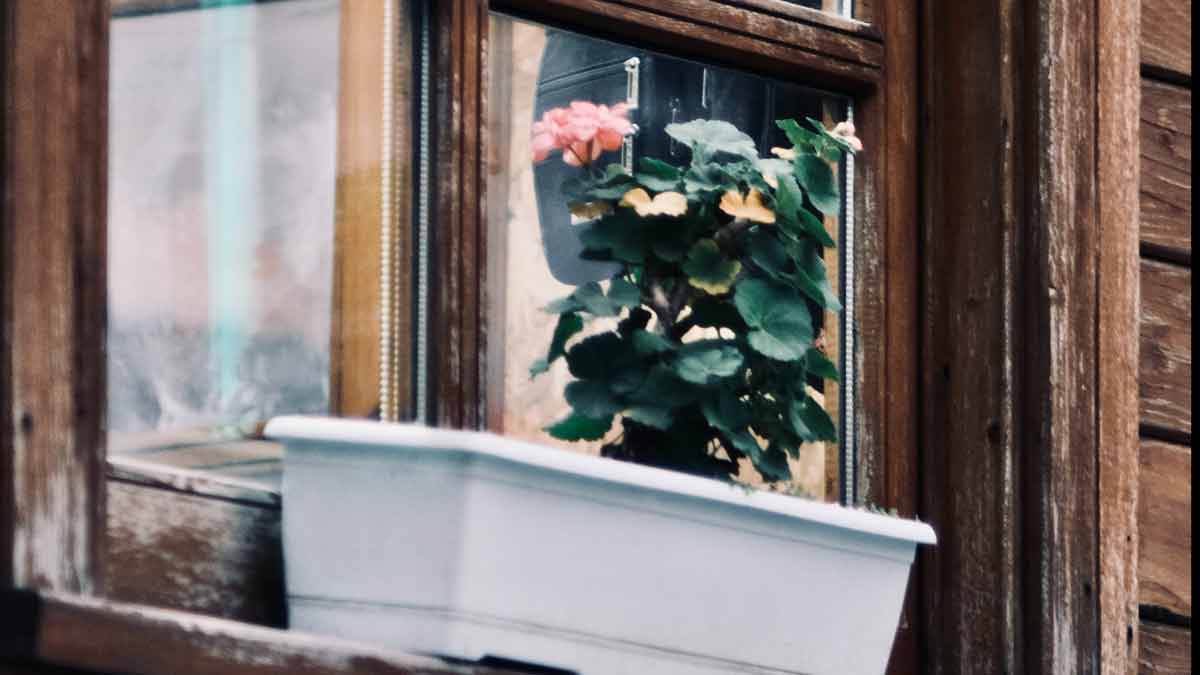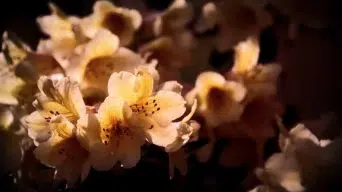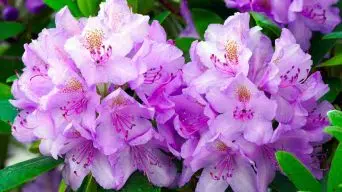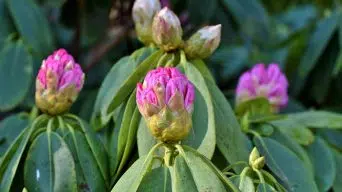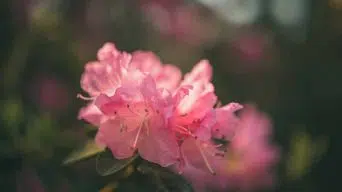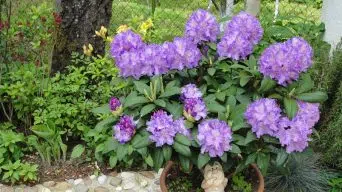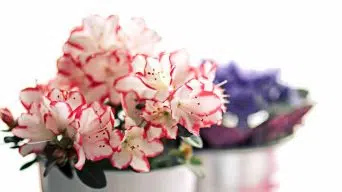Key Takeaways
- Proper pot size and well-draining, acidic soil are crucial for the health and growth of potted rhododendrons.
- Overwatering, underwatering, poor drainage, nutrient deficiencies, and pest infestations are common problems affecting potted rhododendrons.
- Proper watering techniques using a moisture meter or finger to check soil moisture levels before watering can prevent over or underwatering issues. Mulching with organic matter around the base of your Rhododendron helps retain moisture in the soil while providing essential nutrients.
- Regular maintenance, such as pruning dead or damaged foliage, can promote healthy growth in your potted Rhododendron plant.
Rhododendrons are a stunning addition to any garden or indoor space, known for their vibrant flowers and lush foliage.
However, these popular plants can encounter various issues when grown in pots, ranging from pests to diseases and improper care.
In this blog post, we’ll explore common problems potted rhododendrons face, reveal the possible causes and offer effective solutions to help your plant thrive again.
Common Rhododendron Problems in Pots
If you have rhododendrons in pots, you may encounter issues such as yellow leaves, stunted growth, root rot, plants being too tightly packed in the pot, and problems caused by over or underwatering, poor drainage, nutrient deficiencies, or excessive fertilization.
Yellowing Leaves
One of the most prevalent issues that rhododendron owners face is yellowing leaves.
This discolored foliage can result from various factors, including fungal leaf spots, root rot, edema, and chlorosis.
For instance, fungal leaf spots appear as small yellow to brown speckles on the leaves and usually indicate an underlying infection that should be addressed promptly.
Identifying the specific cause behind yellowing leaves is crucial for taking appropriate steps toward rectifying it.
You may need to adjust your watering schedule or improve soil drainage to prevent overwatering-related issues like root rot.
Alternatively, fertilizer or amending soil conditions can correct nutrient deficiencies and help restore your potted Rhododendron to its vibrant green glory.
Poor Growth
Poor growth in potted Rhododendrons is often a result of unfavorable environmental conditions or poor care practices.
For example, inadequate pot size can lead to inhibited root development, while wrong soil type and insufficient nutrient levels deprive the plant of essential nourishment needed for healthy growth.
To address these issues and promote more robust growth in your Rhododendron plants, opt for an appropriate pot size that allows room for root expansion without becoming too large.
Choose well-draining ericaceous compost as your soil mix to provide ample nutrients while helping maintain the ideal acidic conditions necessary for this acid-loving plant species.
Monitor watering habits closely – water only when the top inch of compost feels dry to the touch – as consistent moisture is crucial in preventing drought stress which could stunt the plant’s overall development.
Root Rot
Root rot is a common issue that plagues Rhododendrons grown in pots, often caused by the Phytophthora cinnamomi fungus.
This fungal infection attacks the roots of your precious plant, leading to dull yellow leaves that begin to curl downward and inward, eventually displaying wilting symptoms.
Using well-draining soil and avoiding overwatering is crucial to prevent root rot from taking hold in your potted Rhododendron.
Ensure the container has drainage holes at the bottom so excess water can escape easily.
Additionally, you should be mindful of watering frequency; too much moisture can create an ideal environment for fungal growth.
Root-bound Plants
One of the most common problems associated with container-grown Rhododendrons is root-bound plants.
This occurs when a plant’s roots overgrow in their container, causing them to become tangled and ultimately limiting their growth.
As a result, these plants may experience poor growth and reduced flowering.
To prevent this issue, choosing an appropriate pot size that allows ample room for the plant’s roots to grow is important.
It’s also important to note that root-bound plants can lead to other issues, such as poor drainage and susceptibility to pests and diseases.
Therefore, ensuring healthy root development in container-grown Rhododendrons is crucial for overall plant health.
Overwatering And Underwatering
One of the most common problems with growing rhododendrons in pots is overwatering and underwatering.
Overwatering can lead to yellow leaves that drop off, while underwatering causes dry and brittle leaves.
Proper drainage is crucial when growing rhododendrons in pots to avoid these issues.
Check soil moisture regularly by touching the surface and watering only when it feels dry to the touch about an inch down.
Adjust watering accordingly based on soil moisture levels.
Remember that each pot location may have different humidity levels, affecting how often you water your rhododendron plant.
Poor Drainage
Poor drainage is a common problem affecting the health and growth of rhododendrons in pots.
Inadequate drainage can lead to waterlogged soil, which deprives the plant’s roots of oxygen and can cause them to rot.
It can also increase the risk of fungal infections like Phytophthora root rot and leaf spot.
Choosing pots with proper drainage holes is important to avoid poor drainage issues.
Additionally, it is essential to use well-draining soils when potting rhododendrons.
Regularly checking for problems related to poor drainage, such as yellowing leaves or stunted growth due to insufficient oxygenation, will help prevent severe damage while ensuring healthy growth for years.
Nutrient Deficiencies
Nutrient deficiencies in potted rhododendrons can lead to many problems, including yellowing leaves, stunted growth, and poor flower production.
Some common nutrients essential for your Rhododendron’s health include nitrogen, phosphorus, and potassium.
It’s important to note that nutrient deficiency symptoms can often be mistaken for those caused by pests or diseases.
For instance, yellowing leaves may indicate a lack of nitrogen or a possible pest infestation.
To avoid these issues, it is crucial to ensure that you use the correct potting soil and fertilizers specific to acid-loving plants like rhododendrons.
Overfertilization
Overfertilization is a common problem that can affect the growth and health of potted rhododendrons.
Too much fertilizer can cause stunted growth, root damage, and leaf discoloration in these plants.
Following the recommended dosage instructions on the packaging is crucial to prevent overfertilization.
Avoid fertilizing during winter when plants are dormant and not actively growing.
Proper watering and drainage also play an essential role in preventing overfertilization – excess water can wash away nutrients from the soil.
In contrast, poor drainage can cause nutrients to accumulate around the roots.
Causes Of Rhododendron Problems In Pots
Rhododendron problems in pots can be caused by using the wrong pot size, low-quality soil, and insufficient nutrients.
Inadequate Pot Size
Inadequate pot size is one of the pots’ most common causes of rhododendron problems.
When a plant outgrows its container, it can become root-bound, meaning the roots have grown to fill up all available space and are struggling to find more nutrients or water.
This often results in poor growth and yellowing leaves as the plant struggles to use enough resources.
To avoid this issue, choose a pot at least two inches wider than the root ball of your Rhododendron when planting.
Poor Soil Quality
Rhododendrons in pots require well-draining soil rich in organic matter and slightly acidic.
Conversely, alkaline soils or heavy clay may affect the plant’s growth and development.
A pH test can determine if soil acidity affects your Rhododendron’s ability to absorb nutrients from the soil effectively.
To ensure good quality soil for your potted Rhododendron, use ericaceous compost mixed with pine bark mulch for better drainage.
You’ll also want to add some perlite or vermiculite to enhance the mix’s fertility while aerating it simultaneously.
If possible, collect pine needles from around your yard; these make an excellent additional layer of mulch on top of the potting mix, which will help keep moisture levels even throughout hot summer days.
Lack Of Nutrients
Rhododendrons and Azaleas require adequate nutrients to grow healthy leaves, flowers, and roots.
A lack of nutrients in potted plants can lead to yellowing leaves, stunted growth, fewer blooms, and even death.
Nitrogen is a crucial nutrient for Rhododendrons and Azaleas because it promotes new growth and leaf development.
Ensure you use a high-quality potting mix with added organic matter to prevent nutrient deficiencies in your potted Rhododendrons or Azaleas.
Also, if necessary, add fertilizer regularly with balanced nutrients or specific micronutrients like iron.
Watering And Drainage Issues
Watering and drainage are crucial factors in growing rhododendrons in pots.
Proper watering techniques can prevent issues like over or underwatering, which can cause yellow leaves, poor growth, and root rot.
Use a pot with good drainage holes at the bottom to ensure your potted Rhododendron gets enough water without waterlogged soil.
You should also raise the pot off the ground using bricks or blocks to avoid blocking drainage holes.
If you notice problems with waterlogging or poor drainage despite using well-draining soil and an appropriate-sized pot with good drainage holes, consider adding sand or perlite to improve aeration and prevent compaction of the soil structure.
Solutions To Rhododendron Problems In Pots
If you’re facing problems with growing rhododendrons in pots, some solutions can help.
Ensure that you select the right pot size and soil type.
Proper watering techniques must also be followed, along with providing adequate nutrients.
It’s important to promptly identify and treat pests and diseases and prune the plants regularly.
Choosing A Suitable Pot Size And Soil Type
When growing rhododendrons in pots, choosing the right pot size and soil type is crucial to their success.
Here are some tips for selecting the best options:
- Pot size: Rhododendrons have shallow roots, so it’s important to choose a wide container rather than a deep one. A 12-16 inch diameter pot is recommended for most varieties.
- Soil type: Rhododendrons prefer well-draining, acidic soil with a pH between 4.5 and 6.0. Ericaceous compost or a mix of peat moss, pine bark, and perlite are good choices for planting medium. Avoid using regular potting soil as it may be too alkaline for these acid-loving plants.
Using Proper Watering Techniques
Proper watering is essential to ensure the health of your rhododendrons in pots.
Overwatering or underwatering can lead to various problems, including root rot and poor growth.
Here are some tips for using proper watering techniques:
- Water your pot-grown rhododendrons regularly during the growing season when the soil surface is dry to the touch.
- Use a moisture meter or a finger to check soil moisture levels before watering: if the soil feels cool or moist to the touch, it probably doesn’t need water.
- Water deeply but slowly, allowing water to soak down into the root ball without running off from drainage holes.
- Avoid getting water on leaves or flower buds, as excess moisture can promote diseases like powdery mildew.
- Mulch around the base of your Rhododendron with organic matter such as compost, pine bark mulch, or pine needles to help retain moisture in the soil and prevent water evaporation.
Ensuring Proper Drainage
Proper drainage is essential to keep your Rhododendron healthy and thriving in a pot.
Poor drainage can cause root rot, ultimately leading to your plant’s death.
To ensure proper drainage, ensure your pot has sufficient holes for water to drain out easily.
It’s important not to overwater your Rhododendron since stagnant water can cause issues.
Most problems with potted rhododendrons arise from too much watering rather than under-watering.
A good rule of thumb is to check if the top inch or two inches of soil are dry before watering again.
Providing Adequate Nutrients
Adequate nutrients are essential for solving rhododendron problems in pots.
Here are some tips to ensure that your plants get the nutrients they need:
- Use a slow-release fertilizer specially formulated for acid-loving plants.
- Apply fertilizers during the growing season, avoiding the dormant period.
- Add compost and organic matter to the soil to improve nutrient levels.
- Monitor pH levels and adjust accordingly using horticultural lime or sulfur.
- Avoid over-fertilization, which can lead to burned roots and poor growth.
Providing adequate nutrients can help your rhododendrons thrive in pots and avoid common problems such as yellowing leaves or poor growth.
Identifying And Treating Pests And Diseases
Identifying and treating pests and diseases is important to maintaining healthy Rhododendron potted plants.
Here are some common pests and diseases, along with their identification and treatment methods:
- Vine Weevils – These pests can cause the sudden death of Rhododendron plants. Look for notched edges on the leaves or chewed roots. Treat infestations by applying biological control like nematodes or by using insecticides.
- Bud Blast – This disease causes buds to brown and die before they bloom. It is caused by the fungus Pycnostysanus azalea, which spreads via the Rhododendron leafhopper. Remove infected buds immediately to prevent further spread.
- Powdery Mildew – This fungal infection appears as white powder on leaves and stems. It can be treated with fungicides or prevented by keeping plants well-ventilated and dry.
- Leaf Spot – This disease is caused by fungi that create brown spots on leaves, which may eventually fall off the plant. Remove affected leaves and treat them with fungicides if necessary.
- Scale Insects – These tiny insects attach themselves to the undersides of leaves and suck sap from the plant, causing wilting or yellowing of leaves. Use insecticidal soap or horticultural oil to control infestations.
By identifying these common pests and diseases early on, you can treat them effectively and prevent further damage to your Rhododendron plants in pots.
Keep a watchful eye on your plants, look for signs of trouble regularly, and take appropriate action as needed to keep your plants healthy and thriving all year round!
Pruning Regularly
Regular pruning is an essential solution to common problems with Rhododendrons in pots.
Pruning helps maintain the plant’s shape, keeps it healthy, and prevents fungal infections from spreading.
One important aspect of rhododendron pruning is the timing – pruning should be done six weeks after flowering has finished.
When done correctly, pruning can revitalize a struggling Rhododendron by removing dead or damaged leaves and branches.
However, incorrect pruning techniques or deadheading can cause issues such as no buds forming on the plant.
Regularly checking for these signs of over-pruning will help keep your Rhododendron looking its best all year round.
Prevention Methods To Avoid Rhododendron Problems In Pots
You can take several preventative measures to avoid common problems with rhododendrons in pots.
These include selecting appropriate locations for your pots, ensuring they receive the right amount of sunlight and temperature, monitoring pH levels, inspecting for pests regularly, and utilizing organic fertilizers.
Choosing Suitable Pot Locations
Choosing a suitable location for your plants is important to ensure healthy growth and prevent common rhododendron problems in pots.
Rhododendrons thrive in partially shaded areas with protection from the wind.
Direct sunlight can scorch their leaves, while strong winds damage or break branches.
If you’re unsure where to place your pot-grown rhododendrons, consider observing your garden’s sun and shade patterns throughout the day.
Consider taking note of prevailing winds that occur frequently during certain times of the year.
Providing Optimal Sunlight And Temperature Conditions
Offering optimal sunlight and temperature conditions is crucial to ensure your Rhododendrons thrive in their pots.
These plants love full sun, but they also need a balance of shade depending on the cultivar and location.
For instance, some varieties can tolerate full sun with consistent watering throughout the day.
Temperature is another critical factor to consider when growing Rhododendrons in pots.
These plants do well in moderate temperatures between 60-70°F during the daytime and cooler temperatures around 50°F at night.
Too much heat can cause buds to wither, while frosty temperatures may lead to leaf scorching or bud blast.
Consider placing your pot near deciduous trees that shed leaves during winter to allow natural light into the space without exposing the plant directly to cold air currents or sudden temperature changes.
Monitoring PH Levels
Another critical factor to consider when growing rhododendrons in pots is the soil’s pH level.
Like many other acid-loving plants, these plants require soil with a slightly acidic pH range between 4.5 and 6.0 for optimal growth and health.
Therefore, monitoring the pH levels regularly ensures they remain within this ideal range.
You can use a home soil test kit or opt for an RHS soil analysis service every three years for accurate results.
An imbalanced pH level can cause stunted foliage growth, yellowing leaves, poor flowering performance, and even root rot caused by fungi like Phytophthora cactorum.
These fungi thrive in alkaline conditions that are unsuitable for rhododendron growth.
Regularly Checking For Pests
Regularly checking for pests is crucial in preventing and addressing rhododendron problems in pots.
Common pests that can attack rhododendrons include scale insects, vine weevils, and spider mites.
To prevent pest infestation, monitor your plants regularly for any signs of damage or discoloration on leaves or flowers.
If you notice an infestation, remove the affected area of the plant immediately and dispose of it properly.
Employing preventative measures such as using organic mulch or companion planting with pest-repelling herbs like mint can also help deter potential invaders from your rhododendron pot.
Using Organic Fertilizers
Organic fertilizers can be a great addition to your rhododendron care routine, but using them correctly is important.
If your garden soil is poor, adding organic fertilizers like compost or well-rotted manure will help provide nutrients and improve overall soil quality.
If you have healthy garden soil, then the need for additional organic fertilizer may not be entirely necessary.
Instead of adding more nutrients than needed, consider using natural mulch materials such as pine bark or oak leaves to help retain moisture in the soil and prevent weed growth.
Tips For Maintaining Healthy Rhododendrons In Pots
If you want to keep your rhododendrons healthy in pots, there are some helpful tips you can follow.
These include checking for watering and drainage problems, adjusting nutrient levels when needed, pruning any dead or damaged leaves, and ensuring the plants have enough support.
Doing these things can help ensure that your rhododendrons stay healthy and strong.
Regularly Checking For Watering And Drainage Issues
Checking for watering and drainage issues is essential to keeping your rhododendrons healthy in pots.
Overwatering can cause root rot while underwatering can lead to wilted and droopy plants.
Regularly check the soil moisture by sticking your finger 1 inch down into the soil.
If it feels dry, give the plant some water until it drains out of the bottom of the pot.
Be sure not to let the plant sit in standing water, as this can also lead to problems with roots.
Adjusting Nutrient Levels As Required
Rhododendrons in pots require certain nutrients to thrive and maintain their health.
Plant owners must adjust nutrient levels as required based on the symptoms observed.
For instance, a lack of nitrogen may cause stunted growth and small leaves, while a phosphorus deficiency could lead to discoloration and poor flowering.
Adding organic matter such as compost or using fertilizers containing adequate amounts of essential macronutrients like nitrogen (N), phosphorous (P), and potassium (K) can help address these issues.
Pruning Dead Or Damaged Leaves
Pruning dead or damaged leaves is essential for maintaining healthy rhododendrons in pots.
Dead or damaged leaves can be a sign of fungal infections, pests, or inadequate watering.
To prune the affected leaves, first sterilize your pruning shears with rubbing alcohol to prevent the spread of any disease.
Regularly pruning your Rhododendron will keep it looking attractive and help promote new growth.
Be cautious when pruning, and don’t overdo it, as too much trimming can stress out your plant.
Remember to take care of your Rhododendron throughout all seasons – during winter months, protect them from frost damage, and in summer months, provide adequate shade if they are getting too much direct sunlight.
Providing Adequate Support
To ensure that your Rhododendron planted in a pot gets its support, you must regularly prune and shape it.
This prevents the plant from becoming lopsided and helps distribute nutrients evenly.
If your Rhododendron grows tall and spindly, consider staking or tying it up to provide additional support.
You can use stakes made of bamboo or wooden dowels and secure them to the pot with twine or wire ties.
Alternatively, you can install a trellis behind the pot for added stability.
Final Thoughts
Taking care of rhododendrons in pots can be challenging but ultimately rewarding.
By identifying and addressing common problems like inadequate soil quality, poor drainage, water issues, and pest infestations, you can help your plants thrive.
Regular maintenance, such as pruning dead or damaged foliage, providing adequate support for heavy blooms, and adjusting nutrient levels, will keep your plants healthy.
Remember to choose a suitable location with optimal sunlight exposure and temperature conditions for the best results.

